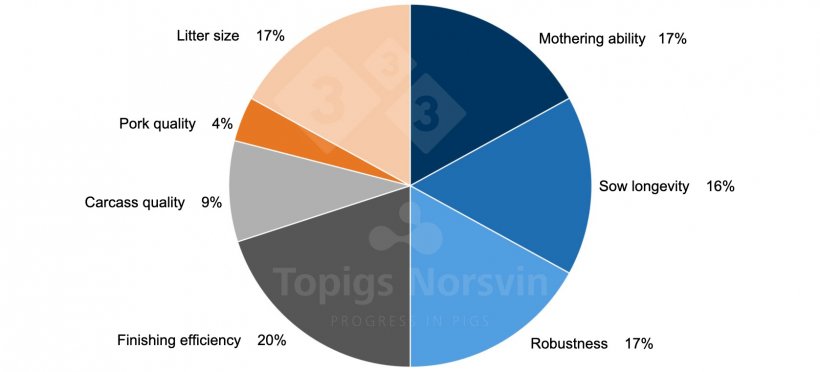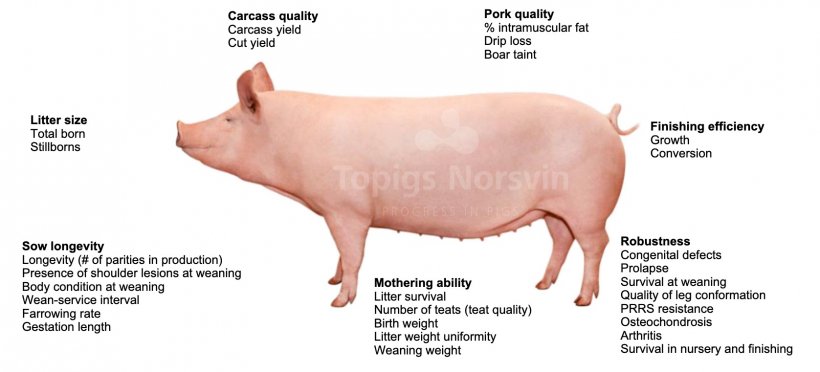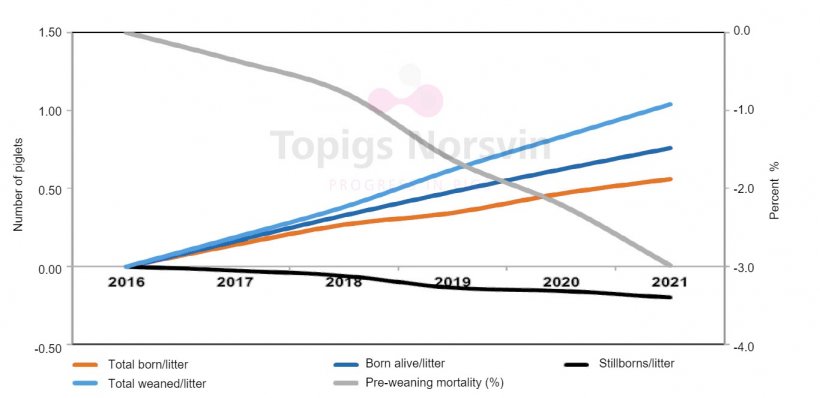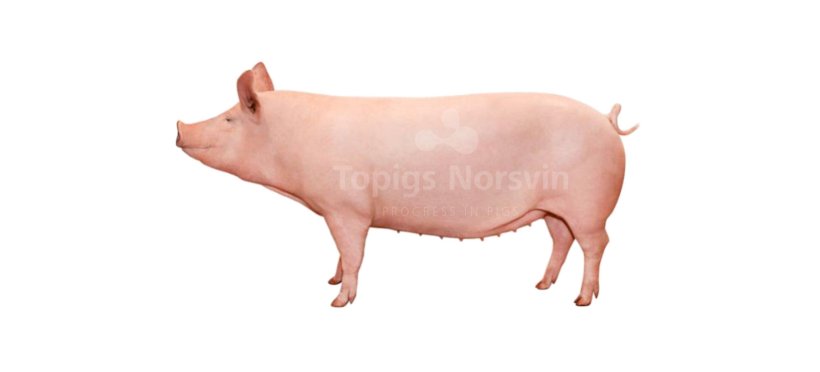Sánchez-Osorio explains that we will focus on the TN70, the sow that accounts for more than 90% of Topigs Norsvin's F1 hybrid sales, but mentions that they also have an alternative hybrid, the TN60 sow, aimed at markets looking for greater robustness or better pork quality.
If he had to describe TN70 in one word, it would be "balance." He considers that the sow offers good production indexes, both in the reproduction phase and in the finishing phase. At the same time, the sow is easy to handle and has a level of robustness that allows it to take advantage of its genetics even in less-than-optimal environmental or management conditions.

Selection criteria and objectives
Figure 1 shows the selection objectives and their respective weights. The selection objective of the TN70 reflects the balanced selection philosophy of Topigs Norsvin. Therefore, in addition to the more classical objectives such as prolificacy or mothering ability, other objectives such as longevity and robustness are added. The weight of the different objectives is similar.

Figure 1. The 2023 selection target for TN70 includes 41 different traits. The selection objective reflects the vision for the TN70 as a highly self-sufficient hyperprolific sow that is set apart by her increased mothering ability and robustness.
Figure 2 visually illustrates the characteristics that make up each of the objectives.

Parameters included in the selection target of line TN70
Below, Sánchez-Osorio explains in further detail how the most important traits are measured.
Litter size
Selection to increase litter size has always been based on the selection for total born and stillbirths with the objective being that any increase in total born would not translate into an increase in stillbirths. Thus, the objective is to increase litter size while keeping stillbirths stable or even decreasing them, as shown by the genetic trend obtained in the TN70 sow in recent years (Figure 3).

Genetic trends for TN70
Sánchez-Osorio adds that, given how the genetic correlation between these traits works, selection on the basis of increasing born alive alone would be accompanied by an increase in stillbirths as well.
Robustness
Selection for these traits aims to obtain animals that are able to cope with different types of challenges in terms of environment, health, etc. without compromising their performance. Protocols related to robustness cover a wide range of traits.
- Survival protocol. This has been incorporated into the selection index for more than 20 years and includes weighing piglets at birth (live and dead) and/or at 21 days of life, as well as the recording of all piglet fosttering and preweaning mortality at the individual level on the selection farms (more than 750,000 piglets are recorded per year).
- Quality of leg conformation Our external protocol includes the evaluation of more than 20 traits that include hoof size, type of gait, position and angle of the joints, walking movement, etc., and genetic values are estimated for all of these.
- In addition, the use of large-scale computerized tomography has allowed us to evaluate lesions associated with osteochondrosis and arthritis (one of the main causes of lameness) and to estimate genetic values that are also included in the selection objective.
- PRRSv resistance: Recent research in the USA identified a genetic marker associated with animals having a higher tolerance against PRRS infection. This marker is included in the selection objectives of our lines to increase the percentage of animals that show this natural resistance to the disease.
- Prolapse: Although in most cases they do not have a genetic background, recent studies have allowed us to determine the existence of a hereditary component (22% of phenotypic variation is explained by genetics), which allows us to work on selection to reduce the incidence.
- Congenital defects. Our screening program includes recording the main congenital defects (inguinal, umbilical, and scrotal hernias, anal atresia, cryptorchidism, hermaphroditism) with which genetic values are estimated to monitor and keep congenital defects within normal ranges.
Sow longevity
This includes the evaluation of body condition and shoulder lesions at weaning, wean-to-service interval, fertility, etc., as these are some of the parameters that are related to how long a sow remains on the farm.
Mothering ability
Weighing piglets at birth and at 21 days, recording the number of teats and teat characteristics, and recording piglet survival play a key role in improving the mothering ability of sows.
Finishing traits
In finishing and slaughter pigs, 50% of the genetic merit depends on the dam and therefore we do not lose sight of the fact that finishing traits are also very important in dam lines.
- Growth and feed conversion, individual data are included via feeding stations and have an important weight (20%) within the line's selection objective.
- Carcass quality. The yield of the carcass and of the main cuts assessed by means of computerized tomography is measured.
- Pork quality. Intramuscular fat, drip loss, and boar taint are evaluated to prevent selecting the more efficient animals that could excessively compromise the quality of the final product.
Finally, Sánchez-Osorio comments that these traits are not only measured in the genetic nucleus but many of them are also measured in commercial farms with conventional production conditions which are connected with the genetic nuclei (CCPS Program) to evaluate the results of the genetic lines in production conditions closer to real ones and that this information is also used to estimate genetic values. In all these farms, genomics is also used to connect the information collected with the animals present in the genetic nuclei.









